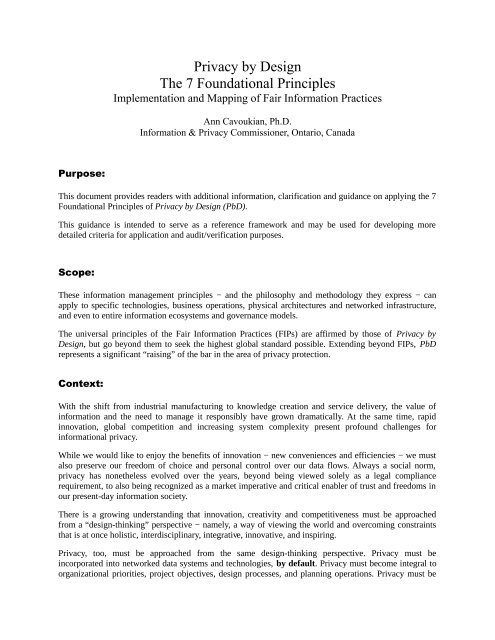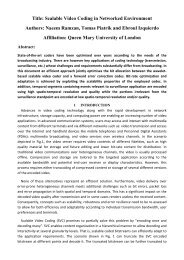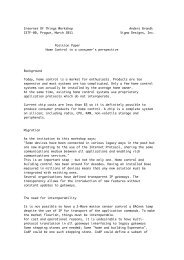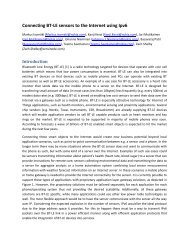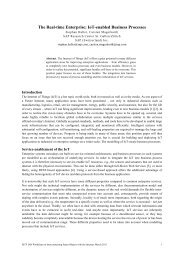Privacy by Design - Foundational Principles
Privacy by Design - Foundational Principles
Privacy by Design - Foundational Principles
Create successful ePaper yourself
Turn your PDF publications into a flip-book with our unique Google optimized e-Paper software.
<strong>Privacy</strong> <strong>by</strong> <strong>Design</strong><br />
The 7 <strong>Foundational</strong> <strong>Principles</strong><br />
Implementation and Mapping of Fair Information Practices<br />
Ann Cavoukian, Ph.D.<br />
Information & <strong>Privacy</strong> Commissioner, Ontario, Canada<br />
Purpose:<br />
This document provides readers with additional information, clarification and guidance on applying the 7<br />
<strong>Foundational</strong> <strong>Principles</strong> of <strong>Privacy</strong> <strong>by</strong> <strong>Design</strong> (PbD).<br />
This guidance is intended to serve as a reference framework and may be used for developing more<br />
detailed criteria for application and audit/verification purposes.<br />
Scope:<br />
These information management principles − and the philosophy and methodology they express − can<br />
apply to specific technologies, business operations, physical architectures and networked infrastructure,<br />
and even to entire information ecosystems and governance models.<br />
The universal principles of the Fair Information Practices (FIPs) are affirmed <strong>by</strong> those of <strong>Privacy</strong> <strong>by</strong><br />
<strong>Design</strong>, but go beyond them to seek the highest global standard possible. Extending beyond FIPs, PbD<br />
represents a significant “raising” of the bar in the area of privacy protection.<br />
Context:<br />
With the shift from industrial manufacturing to knowledge creation and service delivery, the value of<br />
information and the need to manage it responsibly have grown dramatically. At the same time, rapid<br />
innovation, global competition and increasing system complexity present profound challenges for<br />
informational privacy.<br />
While we would like to enjoy the benefits of innovation − new conveniences and efficiencies − we must<br />
also preserve our freedom of choice and personal control over our data flows. Always a social norm,<br />
privacy has nonetheless evolved over the years, beyond being viewed solely as a legal compliance<br />
requirement, to also being recognized as a market imperative and critical enabler of trust and freedoms in<br />
our present-day information society.<br />
There is a growing understanding that innovation, creativity and competitiveness must be approached<br />
from a “design-thinking” perspective − namely, a way of viewing the world and overcoming constraints<br />
that is at once holistic, interdisciplinary, integrative, innovative, and inspiring.<br />
<strong>Privacy</strong>, too, must be approached from the same design-thinking perspective. <strong>Privacy</strong> must be<br />
incorporated into networked data systems and technologies, <strong>by</strong> default. <strong>Privacy</strong> must become integral to<br />
organizational priorities, project objectives, design processes, and planning operations. <strong>Privacy</strong> must be
embedded into every standard, protocol and process that touches our lives. This document seeks to make<br />
this possible <strong>by</strong> striving to establish a universal framework for the strongest protection of privacy<br />
available in the modern era.<br />
The 7 <strong>Foundational</strong> <strong>Principles</strong> of <strong>Privacy</strong> <strong>by</strong> <strong>Design</strong> are presented below in Bold, followed <strong>by</strong> the FIPs<br />
principles that map onto each one.<br />
1. Proactive not Reactive; Preventative not Remedial<br />
The <strong>Privacy</strong> <strong>by</strong> <strong>Design</strong> approach is characterized <strong>by</strong> proactive rather than reactive measures. It<br />
anticipates and prevents privacy invasive events before they happen. PbD does not wait for privacy risks<br />
to materialize, nor does it offer remedies for resolving privacy infractions once they have occurred − it<br />
aims to prevent them from occurring. In short, <strong>Privacy</strong> <strong>by</strong> <strong>Design</strong> comes before-the-fact, not after.<br />
Whether applied to information technologies, organizational practices, physical design, or networked<br />
information ecosystems, PbD begins with an explicit recognition of the value and benefits of proactively<br />
adopting strong privacy practices, early and consistently (for example, preventing (internal) data breaches<br />
from happening in the first place). This implies:<br />
<br />
<br />
<br />
A clear commitment, at the highest levels, to set and enforce high standards of privacy − generally<br />
higher than the standards set out <strong>by</strong> global laws and regulation.<br />
A privacy commitment that is demonstrably shared throughout <strong>by</strong> user communities and stakeholders,<br />
in a culture of continuous improvement.<br />
Established methods to recognize poor privacy designs, anticipate poor privacy practices and<br />
outcomes, and correct any negative impacts, well before they occur in proactive, systematic, and<br />
innovative ways.<br />
2. <strong>Privacy</strong> as the Default<br />
We can all be certain of one thing − the default rules! <strong>Privacy</strong> <strong>by</strong> <strong>Design</strong> seeks to deliver the maximum<br />
degree of privacy <strong>by</strong> ensuring that personal data are automatically protected in any given IT system or<br />
business practice. If an individual does nothing, their privacy still remains intact. No action is required<br />
on the part of the individual to protect their privacy − it is built into the system, <strong>by</strong> default.<br />
This PbD principle, which could be viewed as <strong>Privacy</strong> <strong>by</strong> Default, is particularly informed <strong>by</strong> the<br />
following FIPs:<br />
<br />
<br />
<br />
Purpose Specification – the purposes for which personal information is collected, used, retained and<br />
disclosed shall be communicated to the individual (data subject) at or before the time the information<br />
is collected. Specified purposes should be clear, limited and relevant to the circumstances.<br />
Collection Limitation – the collection of personal information must be fair, lawful and limited to that<br />
which is necessary for the specified purposes.<br />
Data Minimization − the collection of personally identifiable information should be kept to a strict<br />
minimum. The design of programs, information and communications technologies, and systems<br />
should begin with non-identifiable interactions and transactions, as the default. Wherever possible,<br />
identifiability, observability, and linkability of personal information should be minimized.
Use, Retention, and Disclosure Limitation – the use, retention, and disclosure of personal<br />
information shall be limited to the relevant purposes identified to the individual, for which he or she<br />
has consented, except where otherwise required <strong>by</strong> law. Personal information shall be retained only as<br />
long as necessary to fulfill the stated purposes, and then securely destroyed.<br />
Where the need or use of personal information is not clear, there shall be a presumption of privacy and the<br />
precautionary principle shall apply: the default settings shall be the most privacy protective.<br />
3. <strong>Privacy</strong> Embedded into <strong>Design</strong><br />
<strong>Privacy</strong> <strong>by</strong> <strong>Design</strong> is embedded into the design and architecture of IT systems and business practices. It is<br />
not bolted on as an add-on, after the fact. The result is that privacy becomes an essential component of<br />
the core functionality being delivered. <strong>Privacy</strong> is integral to the system, without diminishing functionality.<br />
<strong>Privacy</strong> must be embedded into technologies, operations, and information architectures in a holistic,<br />
integrative and creative way. Holistic, because additional, broader contexts must always be considered.<br />
Integrative, because all stakeholders and interests should be consulted. Creative, because embedding<br />
privacy sometimes means re-inventing existing choices because the alternatives are unacceptable.<br />
<br />
<br />
<br />
A systemic, principled approach to embedding privacy should be adopted − one that relies upon<br />
accepted standards and frameworks, which are amenable to external reviews and audits. All fair<br />
information practices should be applied with equal rigour, at every step in the design and operation.<br />
Wherever possible, detailed privacy impact and risk assessments should be carried out and published,<br />
clearly documenting the privacy risks and all measures taken to mitigate those risks, including<br />
consideration of alternatives and the selection of metrics.<br />
The privacy impacts of the resulting technology, operation or information architecture, and their uses,<br />
should be demonstrably minimized, and not easily degraded through use, misconfiguration or error.<br />
4. Full Functionality – Positive-Sum, not Zero-Sum<br />
<strong>Privacy</strong> <strong>by</strong> <strong>Design</strong> seeks to accommodate all legitimate interests and objectives in a positive-sum “winwin”<br />
manner, not through a dated, zero-sum approach, where unnecessary trade-offs are made. <strong>Privacy</strong><br />
<strong>by</strong> <strong>Design</strong> avoids the pretence of false dichotomies, such as privacy vs. security, demonstrating that it is<br />
possible, and far more desirable, to have both.<br />
<strong>Privacy</strong> <strong>by</strong> <strong>Design</strong> does not simply involve the making of declarations and commitments − it relates to<br />
satisfying all legitimate objectives − not only the privacy goals. <strong>Privacy</strong> <strong>by</strong> <strong>Design</strong> is doubly-enabling in<br />
nature, permitting full functionality − real, practical results and beneficial outcomes to be achieved for<br />
multiple parties.<br />
<br />
<br />
When embedding privacy into a given technology, process, or system, it should be done in such a way<br />
that full functionality is not impaired, and to the greatest extent possible, that all requirements are<br />
optimized.<br />
<strong>Privacy</strong> is often positioned in a zero-sum manner as having to compete with other legitimate interests,<br />
design objectives, and technical capabilities, in a given domain. <strong>Privacy</strong> <strong>by</strong> <strong>Design</strong> rejects taking such
an approach – it embraces legitimate non-privacy objectives and accommodates them, in an<br />
innovative positive-sum manner.<br />
<br />
All interests and objectives must be clearly documented, desired functions articulated, metrics agreed<br />
upon and applied, and trade-offs rejected as often being unnecessary, in favour of finding a solution<br />
that enables multi-functionality.<br />
Additional recognition is garnered for creativity and innovation in achieving all objectives and<br />
functionalities in an integrative, positive-sum manner. Entities that succeed in overcoming outmoded<br />
zero-sum choices are demonstrating first-class global privacy leadership, having achieved the Gold<br />
Standard.<br />
5. End-to-End Security – Lifecycle Protection<br />
<strong>Privacy</strong> <strong>by</strong> <strong>Design</strong>, having been embedded into the system prior to the first element of information being<br />
collected, extends securely throughout the entire lifecycle of the data involved — strong security measures<br />
are essential to privacy, from start to finish. This ensures that all data are securely retained, and then<br />
securely destroyed at the end of the process, in a timely fashion. Thus, <strong>Privacy</strong> <strong>by</strong> <strong>Design</strong> ensures cradle<br />
to grave, secure lifecycle management of information, end-to-end.<br />
<strong>Privacy</strong> must be continuously protected across the entire domain and throughout the life-cycle of the data<br />
in question. There should be no gaps in either protection or accountability. The “Security” principle has<br />
special relevance here because, at its essence, without strong security, there can be no privacy.<br />
<br />
<br />
Security − Entities must assume responsibility for the security of personal information (generally<br />
commensurate with the degree of sensitivity) throughout its entire lifecycle, consistent with standards<br />
that have been developed <strong>by</strong> recognized standards development bodies.<br />
Applied security standards must assure the confidentiality, integrity and availability of personal data<br />
throughout its lifecycle including, inter alia, methods of secure destruction, appropriate encryption,<br />
and strong access control and logging methods.<br />
6. Visibility and Transparency<br />
<strong>Privacy</strong> <strong>by</strong> <strong>Design</strong> seeks to assure all stakeholders that whatever the business practice or technology<br />
involved, it is in fact, operating according to the stated promises and objectives, subject to independent<br />
verification. Its component parts and operations remain visible and transparent, to both users and<br />
providers alike. Remember, trust but verify!<br />
Visibility and transparency are essential to establishing accountability and trust. This PbD principle tracks<br />
well to Fair Information Practices in their entirety, but for auditing purposes, special emphasis may be<br />
placed upon the following FIPs:<br />
<br />
Accountabilty – The collection of personal information entails a duty of care for its protection.<br />
Responsibility for all privacy-related policies and procedures shall be documented and communicated<br />
as appropriate, and assigned to a specified individual. When transferring personal information to third<br />
parties, equivalent privacy protection through contractual or other means shall be secured.
Openness – Openness and transparency are key to accountability. Information about the policies and<br />
practices relating to the management of personal information shall be made readily available to<br />
individuals.<br />
Compliance – Complaint and redress mechanisms should be established, and information<br />
communicated about them to individuals, including how to access the next level of appeal. Necessary<br />
steps to monitor, evaluate, and verify compliance with privacy policies and procedures should be<br />
taken.<br />
7. Respect for User <strong>Privacy</strong><br />
Above all, <strong>Privacy</strong> <strong>by</strong> <strong>Design</strong> requires architects and operators to keep the interests of the individual<br />
uppermost <strong>by</strong> offering such measures as strong privacy defaults, appropriate notice, and empowering<br />
user-friendly options. Keep it user-centric!<br />
The best <strong>Privacy</strong> <strong>by</strong> <strong>Design</strong> results are usually those that are consciously designed around the interests<br />
and needs of individual users, who have the greatest vested interest in the management of their own<br />
personal data.<br />
Empowering data subjects to play an active role in the management of their own data may be the single<br />
most effective check against abuses and misuses of privacy and personal data. Respect for User <strong>Privacy</strong> is<br />
supported <strong>by</strong> the following FIPs:<br />
Consent – The individual’s free and specific consent is required for the collection, use or<br />
disclosure of personal information, except where otherwise permitted <strong>by</strong> law. The greater the<br />
sensitivity of the data, the clearer and more specific the quality of the consent required. Consent may<br />
be withdrawn at a later date.<br />
Accuracy – personal information shall be as accurate, complete, and up-to-date as is necessary to<br />
fulfill the specified purposes.<br />
Access – Individuals shall be provided access to their personal information and informed of its<br />
uses and disclosures. Individuals shall be able to challenge the accuracy and completeness of the<br />
information and have it amended as appropriate.<br />
Compliance – Organizations must establish complaint and redress mechanisms, and<br />
communicate information about them to the public, including how to access the next level of appeal.<br />
Respect for User <strong>Privacy</strong> goes beyond these FIPs, and extends to the need for human-machine interfaces<br />
to be human-centered, user-centric and user-friendly so that informed privacy decisions may be reliably<br />
exercised. Similarly, business operations and physical architectures should also demonstrate the same<br />
degree of consideration for the individual, who should feature prominently at the centre of operations<br />
involving collections of personal data.<br />
+++<br />
Further information and all references at: www.privacy<strong>by</strong>design.ca


